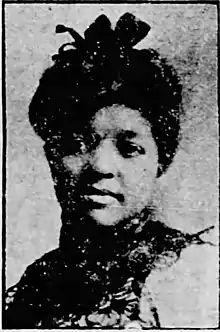Ida Clark DePriest | |
|---|---|
 | |
| Born | 1869 Kansas |
| Died | August 1938 |
| Occupation | Suffragist |
Ida Clark DePriest (c. 1869 – August 1938) was an African-American suffragist, activist, and clubwoman, known for her work for women's suffrage in Colorado.
Biography
Ida Clark was born in Kansas around 1869 to Mary Ellen Clark, and had one brother, Duff.[1][2] Clark grew up in Colorado, graduating from Denver High School in 1889.[3] In 1891, she married painter Richard K. DePriest in 1891, and the couple had a son named Claude H. DePriest around 1895, as well as a second child who died in infancy.[1][4]
Ida C. DePriest dedicated her career to political activism, working to register and educate Colorado's women voters, who had gained suffrage in 1893. Alongside Elizabeth Piper Ensley, she founded the Colored Women's Republican Club of Colorado, which was instrumental in the election of Joseph Henry Stuart, a black lawyer, to the Colorado State Legislature in 1894.[5][6] From 1895 to 1896, DePriest served as Corresponding Secretary to the Woman's League of Denver, an organization affiliated with the State Association of Colored Women's Clubs.[7][8] In 1895, DePriest was elected Vice President of the Colorado State Republican League, and often hosted club meetings and events at her home.[9][10] In October of that year, DePriest and Lizzie Olden attended the first annual meeting of the Colorado Federation of Women's Clubs in Colorado Springs, as the only two black delegates from the Denver Women's League.[11][12] Addressing an audience of mostly white women, DePriest presented a paper discussing trends in popular literature. Her work was well received by the other clubwomen at the meeting.[12]
In addition to her club work, DePriest was also interested in education. She was a founding member of the Colored Women's League of Denver, a chapter of the National Association of Colored Women's Clubs (NACW), organized in 1894 to provide educational and social services to African American children. The club adopted the NACW's motto "Lifting as We Climb."[13] In August 1911, DePriest attended a meeting of the National Negro Educational Congress in Denver as a delegate.[14]
DePriest held a clerk position in the office of Colorado Secretary of State Timothy O'Connor, but resigned in 1909 after becoming the target of racist remarks from Secretary Elect James B. Pearce.[15] Perhaps because few political jobs were open to black women, she later took a position as a maid at The Denver Dry Goods Company.[5] Still, DePriest remained active in various Colorado women's clubs throughout her life, and worked for Denver's Election Commissioner in 1916, registering voters before the presidential election.[1]
DePriest died in August 1938.[1] Though she spent the later years of her life in California with her son, she is buried in Riverside Cemetery in Denver.[16]
References
- 1 2 3 4 Smith, Sode. "Biographical Sketch of Ida Clark DePriest". Women and Social Movements in the United States, 1600-2000. Alexandria, VA: Alexander Street Press. Retrieved 28 March 2020.
- ↑ "Douglas Undertaking Co". Denver Star. Denver, CO. November 4, 1916. Retrieved March 31, 2020.
- ↑ District No. 1 Board of Education (1895). Annual Report of the Board of Education of District No. 1, Arapahoe County, Colo, Volumes 21-28. Denver, CO: W.F. Robinson & Co. p. 225.
{{cite book}}: CS1 maint: numeric names: authors list (link) - ↑ "United States Federal Census Record". Ancestry.com. 1910. Retrieved March 31, 2020.
- 1 2 Higginbotham, Elizabeth; Romero, Mary, eds. (1997). Women and Work: Exploring Race, Ethnicity, and Class. Vol. 6: Women and Work. Thousand Oaks, CA: Sage Publications. p. 220. ISBN 9780803950597.
- ↑ Martinez, Anna (2016). "Five of the Greatest: Joseph Henry Stuart (circa 1851–1910)". Colorado Bar Association. The Colorado Lawyer: The Official Publication of the Colorado Bar Association. Retrieved March 31, 2020.
- ↑ Dickson, Lynda (1997). "Lifting as We Climb: African American Women's Clubs of Denver, 1880-1925". In Jameson, Elizabeth; Armitage, Susan (eds.). Writing the Range: Race, Class, and Culture in the Women's West. Norman, OK: University of Oklahoma Press. p. 374. ISBN 9780806129525.
- ↑ Dickson, Lynda F. (1987). "Toward a Broader Angle of Vision in Uncovering Women's History: Black Women's Clubs Revisited". Frontiers: A Journal of Women Studies. 9 (2): 62–68. doi:10.2307/3346191. JSTOR 3346191.
- ↑ Haley, James T. (1895). Afro-American encyclopaedia : or, The thoughts, doings and sayings of the race; embracing addresses, lectures, biographical sketches ... and a history of the denominations, giving the numerical strength of each. Mind and matter. Nashville, TN: Haley & Florida. p. 224.
- ↑ "To the Club Women of the City". Denver Star. Denver, CO. September 26, 1914. Retrieved March 31, 2020.
- ↑ Hill, Alice Polk (1915). Colorado Pioneers in Picture and Story. Denver, CO: Brock-Haffner Press. pp. 237.
- 1 2 McHenry, Elizabeth (2002). Forgotten Readers: Recovering the Lost History of African American Literary Societies. Durham, NC: Duke University Press. pp. 211-212.
- ↑ Mauck, Laura M. (2001). Five Points Neighborhood of Denver. Images of America. Chicago, IL: Arcadia Publishing. p. 28. ISBN 9780738518701.
- ↑ "Delegates to the Negro National Educational Congress". The Statesman. Denver, CO. June 24, 1911. Retrieved March 31, 2020.
- ↑ "A Little Man in a Big Place". The Statesman. Denver, CO. January 16, 1909. Retrieved March 31, 2020.
- ↑ "Colorado". The Chicago Defender. August 11, 1928. ProQuest 492174134.